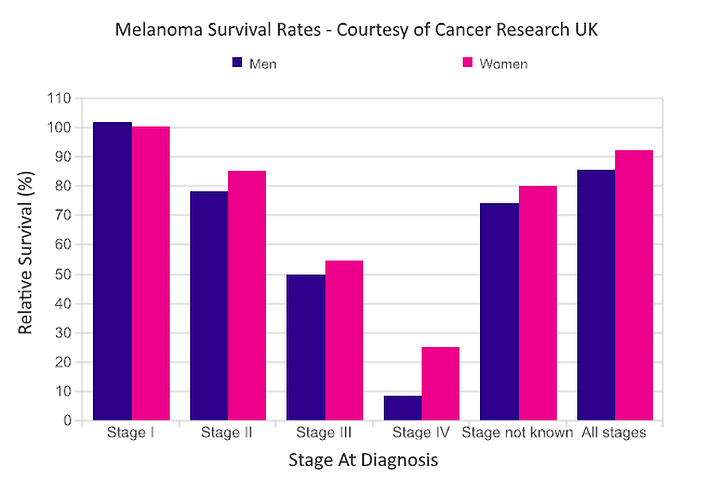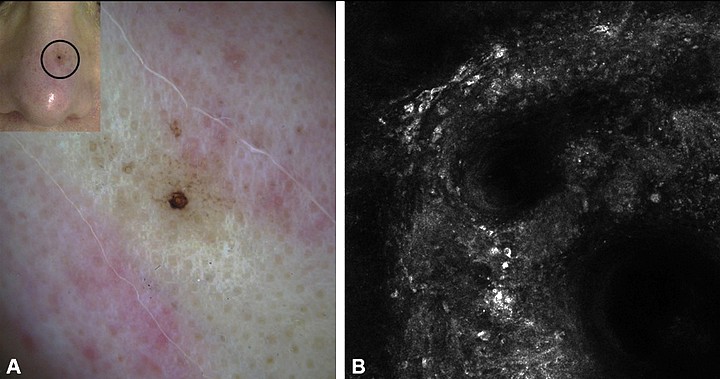
We should begin by mentioning how much skin cancer treatment has improved over recent years. Even so, the message from the chart above is clear, early diagnosis and intervention save lives.
Asking people how seriously they should take melanoma produces differing results. We want to dispel any misunderstanding, through data from a trusted authority.
In July 2016, Cancer Research UK used their latest data to provide an overview. Melanoma is the fifth most prevalent cancer in the UK, with 15,400 people diagnosed each year, compared to 5,600 20 years ago.
Population increase is a factor, along with people living longer. More than 10,000 people over 55 are now diagnosed with malignant melanoma each year. Beyond longevity, they come from a generation where sun seeking holidays became more common.
A belief at the time that a sun tan was healthy and the sunburn on route just part of a process did not help. Over exposure to the sun is the prime cause of skin cancer, with melanoma the most dangerous form.
Melanoma Myths
Beyond the current scale of melanoma, we would like to clarify a few other misconceptions:
- I’m too young to have a melanoma!
- As the data shows, melanoma is more common in older people and often takes a long while to develop but neither of these always apply. If you see worrying signs at any age, you should seek professional advice.
- It’s only skin cancer!
- Damage to your skin from any untreated cancer can be serious but melanoma does not stop at the skin. Left untreated, this will in many cases spread to other tissue, or organs and can be life threatening.
- Melanoma is caused by the sun!
- Staying safe in the sun and avoiding tanning beds are great ways to prevent melanoma. Around 30% of melanoma is not however caused by sun exposure, or other UV sources, genetics can play an important role.
- Melanoma starts in an existing mole!
- This can happen and having a large number of moles is a sign of increased risk. Even so, almost 70% of melanomas develop on previously unmarked skin, the reason all of your skin needs sun protection.
- Melanomas are brown, or black!
- They often are but this is not true all the time, melanomas can appear as pink, or skin coloured spots, or lesions. Any changing area, particularly with an uneven texture, shape, border, or varying colour deserves investigation.
- All Melanomas are a similar shape!
- They can vary in size, or shape, nodular melanoma is a particular example. Often described by the acronym EFG, where E = Elevated F = Firm G = Growing, also a type which may be particularly aggressive
- There’s nothing you can do!
- The opposite feeling on treatment is thankfully correct. Our ability to correctly diagnose and treat melanoma has improved significantly.
Facilities we have to help with diagnosis include a confocal microscope, the only one in a UK private dermatology clinic. A fine aid for skin cancer treatment, not least for hard to diagnose melanoma.
The image below relates to a JAAD case report in an international study from mid 2017. Top left of section A, you can see a real world view of a patient’s nose, with a small (2mm) brown spot close to the middle.

A view using dermoscopy covers the rest of section A and does bring a degree of clarity. Section B, using confocal microscopy, offers far greater depth, literally cell by cell and an ability to identify the cell structure.
To a trained eye, this detailed image of the peripheral cells suggested a diagnosis of melanoma. A view confirmed by later analysis of the tissue.
Melanoma can be fatal, as has been the case for 2,000 of the 10,000 over 55s mentioned earlier. Even so, the number of people surviving through dedicated melanoma treatment is increasing, as new techniques are brought to bear
Managing Melanoma
Prevention is naturally the best course, even if you consider yourself used to the sun. Stay in the shade during peak sunlight hours, cover up with a shirt, hat and sunglasses. You might also wish to see evidence on sunbed use and melanoma.
Neither should you feel being regularly tanned makes you immune, or that precautions don’t matter if you already have damage. Further exposure may just make matters worse.
The most important advice for melanoma, or any skin cancer, is fortunately straightforward. Ignoring symptoms is the worse thing you can do and a common reason for fatalities.
Our London clinic specialises in skin cancer treatment but wherever you are, or whoever you choose to visit, please make sure to seek support if you have any concerns about skin irregularities.
The experience of good consultants and the latest diagnostic equipment can set your mind at rest. If there is a problem, advanced treatment can bring a cure. Melanoma should be a concern but is eminently treatable.
Being informed on melanoma is also useful, you are welcome look through further information on our website:
- Save time with an intuitive search on: Skin Cancer Diagnosis & Treatment.
- Up to date news, research and insights: Our Dedicated Skin Cancer Blog.
- A significant development in seeing beneath your skin: Confocal Microscopy.
- From screening to surgery, the details of: Melanoma Diagnosis & Treatment.
